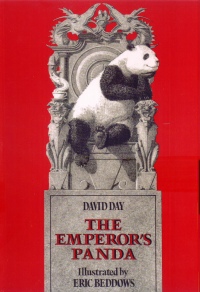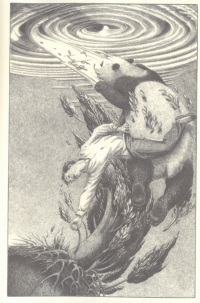| ________________
CM . . .
. Volume XX Number 11. . . .November 15, 2013 
 |
The Emperor’s Panda.
David Day. Illustrated by Eric Beddows.
Toronto, ON: Fourfront Editions/Quattro Books, 2013.
109 pp., trade pbk., $18.00.
ISBN 978-1-927443-51-4.
Grades 7 and up / Ages 12 and up.
Review by Huai-Yang Lim.
*** /4
|
| |
|

excerpt:
Through many ages and dynasties the Panda advised in the emperors’ courts, but one day, over a thousand years ago, he went out for a walk in the imperial gardens and was never seen again. Many believed the Master Panda had returned to the Ninth Heaven.
So the sight of the Panda munching on a bamboo stalk across the clearing from Kung was enough to convince the boy that this was all a dream. He was even more convinced when he saw the Panda’s bright eyes settling on him and a deep but gentle voice came from the bear-like creature. “Good morning, young Kung.”
Kung was so astonished, he could not make even a polite reply, but instead pinched himself very, very hard. “Ouch!” he yelped.
Originally published in 1986 in five languages, this reissued edition of David Day’s first children’s book, The Emperor’s Panda, continues to be a highly readable and engaging story for young readers who wish to gain some insight about China through a creative fairy tale. Winner of an IBBY international award, it was adapted as a theatre production by the Young People’s Theatre of Toronto and was also the runner-up for the Governor General’s Award and National Library Award. This book’s first edition coincided with the first pandas that visited Canada nearly 30 years ago, during which time they stayed at the Toronto Zoo and served as the author’s inspiration for this story. The 2013 reissued edition coincides with the most recent visit of Chinese pandas to Canada.
Illustrated by Eric Beddows, The Emperor's Panda is about the world’s first panda, named Lord Beishung, and a shepherd boy, named Kung, who is a flute-player in a land called Sung Wu. When three mysterious travellers visit Kung’s village and leave with his uncle, Latzu, the uncle does not return. Realizing that the strangers may have kidnapped his uncle, Kung goes on a journey to save him. Along the way, he encounters a variety of dangers, but he also befriends Lord Beishung as well as other people. When the Emperor of China announces that he will give his daughter’s hand in marriage to those who bring him the mythical Panda, the three evil wizards capture it. The story culminates with a pivotal climax during which the entire kingdom’s fate is tenuous, and it risks falling into evil hands.
Although it is plot-driven in many respects, Day’s book depicts evocative characters and settings that add to the story’s realism for readers who can imagine themselves in that same world. His inclusion of Chinese history and culture adds narrative flavour and increases the reality and believability of the narrative as a story that could happen, even if it is entirely fictional. Beddow’s attractive black-and-white images complement the text by contributing to its characterization and highlighting important moments in the plot. For example, the drawing of the caravan train that is heading to the Imperial City helps to solidify Day’s textual description of it, while the close-up image of the evil Black Pearl contributes to its ominous impression in that part of the book.
Despite the book’s appeal, it would be important for readers to recognize that Day’s book is a fictional, rather than an accurate, representation of Chinese history and culture. This may raise issues pertaining to the historical representation of people of Chinese descent in which such representations were predominantly made by people of non-Chinese background. Given that the book was initially published in 1986, one possible issue to consider is whether the book’s attractiveness and popularity at the time were because it depicted a culture that was exotic and unfamiliar for Western audiences. Greater awareness and understanding about the world’s diverse cultures exists today and is enhanced by the Internet and the proliferation of exported cultural products—both of which allow people to learn about and connect with other cultures worldwide. In contrast, such opportunities for intercultural contact and exchange were less prevalent a few decades ago.
Although Day does incorporate various social and cultural elements from the Chinese context, his book is perhaps more accurately identified as a hybrid text because it melds elements from different cultural and narrative contexts. Besides its references to Chinese history, culture, and mythology, the book also includes elements that evoke Western fairy tales, Greek mythology, and even Celtic traditions. For example, the narrative structure of Day’s book is reminiscent of the plot, setting, and character elements found frequently in Western fairytales and fantasy narratives. These include a battle between good and evil, a romance, and an overarching quest narrative, as well as tropes such as the wise old man—as embodied anthropomorphically by the Panda and by Kung’s uncle—and the individual hero with a pureness of heart—as represented by Kung. Settings in the book include the Enchanted Valley, Forbidden Mountains, Imperial City, and mystical bamboo grove where the Master Panda Lord Beishung lives, all of which constitute a blending of Western and Eastern traditions. In addition, some Western fairytales also include a plot element—similar to what is in this story—whereby the king offers his daughter to a man who successfully completes a task or quest. The book also includes characters such as the gnome, unicorn, Minotaur, Gorgon, and High Priestess of the Moon, all of which evoke other narrative traditions. A creature similar to the Western unicorn is spoken about in Chinese culture, but it is actually a fusion of different creatures as it consists of a deer’s body, ox’s tail, and horse’s hooves.
In relation to these elements, the book also incorporates elements from Chinese mythology that may not be entirely accurate. One of its most evident departures from Chinese mythology is the book’s reference to evil fire dragons, something which Lord Beishung mentions in the tale that he relates to Kung. It refers to the “fiery demons of chaos [that] forged black pearls—gems of evil—and about these were made the terrible monsters called the fire dragons” (pp. 40-41). However, dragons are not evil in Chinese mythology as they are typically represented as benevolent spiritual creatures associated with wisdom and the seasons. In addition, they do not typically have pearls buried in their brains (as Day’s book mentions for the Fire Dragons), much less evil pearls. The book’s reference to the world’s first panda Lord Beishung is also not commonly found in Chinese mythology, although a reference does exist for a legend that “tells of an emperor receiving ideas on how to run his government from a bear who visited his bedroom at night” (http://www.kinezika.info/pdf/ChineseMythology.pdf). However, Day has taken this idea and incorporated it as a central part of the narrative.
 This is not to suggest that Day’s book is not engaging for young readers since it can be rightfully recognized as a textually interesting and appealing story for young audiences. Despite the liberties that have been taken with the different cultural, historical, and narrative elements that Day has woven together, it is this very process that has contributed to an appealing story for young readers. The book strikes a good balance among plot development, description of the setting, and characterization by using different narrative techniques, such as exposition and interior monologue, to shape a well-told narrative. As a result, readers can visualize Kung’s world vividly which, in turn, contributes to the story’s appeal because it helps to contextualize the plot by evoking a specific cultural backdrop and time period.
This is not to suggest that Day’s book is not engaging for young readers since it can be rightfully recognized as a textually interesting and appealing story for young audiences. Despite the liberties that have been taken with the different cultural, historical, and narrative elements that Day has woven together, it is this very process that has contributed to an appealing story for young readers. The book strikes a good balance among plot development, description of the setting, and characterization by using different narrative techniques, such as exposition and interior monologue, to shape a well-told narrative. As a result, readers can visualize Kung’s world vividly which, in turn, contributes to the story’s appeal because it helps to contextualize the plot by evoking a specific cultural backdrop and time period.
The book’s length and complexity of its language are appropriate for its intended readership. Readers will find the book appealing because of its plot and interesting characters, coupled with the element of a quest. Given its mythological bent, Day’s book will be appropriate for a variety of library collections such as the school, public, and academic libraries. The Emperor’s Panda is organized into readable chapters with chapter titles that preface its content. It can be used in the classroom in various ways to discuss issues pertaining to Chinese history and culture, children’s literature, or broader issues such as ethnic minority fiction. In a university context, it can be taught as part of a children’s literature class or as part of a class on Chinese history and culture. However, it would again be important to distinguish this book from “actual” Chinese mythology and history.
A prolific author, David Day has published several children’s books that are circulated worldwide. He has written over 40 books of poetry, ecology, history, fantasy, mythology, and fiction, with his books translated into twenty languages. More information about David Day is available from his official website at http://www.daviddaybooks.com/.
Recommended with reservations.
Huai-Yang Lim has a degree in Library and Information Studies. He enjoys reading, reviewing, and writing children’s literature in his spare time.

To comment
on this title or this review, send mail to cm@umanitoba.ca.
Copyright © the Manitoba Library Association. Reproduction for personal
use is permitted only if this copyright notice is maintained. Any
other reproduction is prohibited without permission.
NEXT REVIEW |
TABLE OF CONTENTS FOR THIS ISSUE
- November 15, 2013.
AUTHORS |
TITLES |
MEDIA REVIEWS |
PROFILES |
BACK ISSUES |
SEARCH |
CMARCHIVE |
HOME |

 This is not to suggest that Day’s book is not engaging for young readers since it can be rightfully recognized as a textually interesting and appealing story for young audiences. Despite the liberties that have been taken with the different cultural, historical, and narrative elements that Day has woven together, it is this very process that has contributed to an appealing story for young readers. The book strikes a good balance among plot development, description of the setting, and characterization by using different narrative techniques, such as exposition and interior monologue, to shape a well-told narrative. As a result, readers can visualize Kung’s world vividly which, in turn, contributes to the story’s appeal because it helps to contextualize the plot by evoking a specific cultural backdrop and time period.
This is not to suggest that Day’s book is not engaging for young readers since it can be rightfully recognized as a textually interesting and appealing story for young audiences. Despite the liberties that have been taken with the different cultural, historical, and narrative elements that Day has woven together, it is this very process that has contributed to an appealing story for young readers. The book strikes a good balance among plot development, description of the setting, and characterization by using different narrative techniques, such as exposition and interior monologue, to shape a well-told narrative. As a result, readers can visualize Kung’s world vividly which, in turn, contributes to the story’s appeal because it helps to contextualize the plot by evoking a specific cultural backdrop and time period.